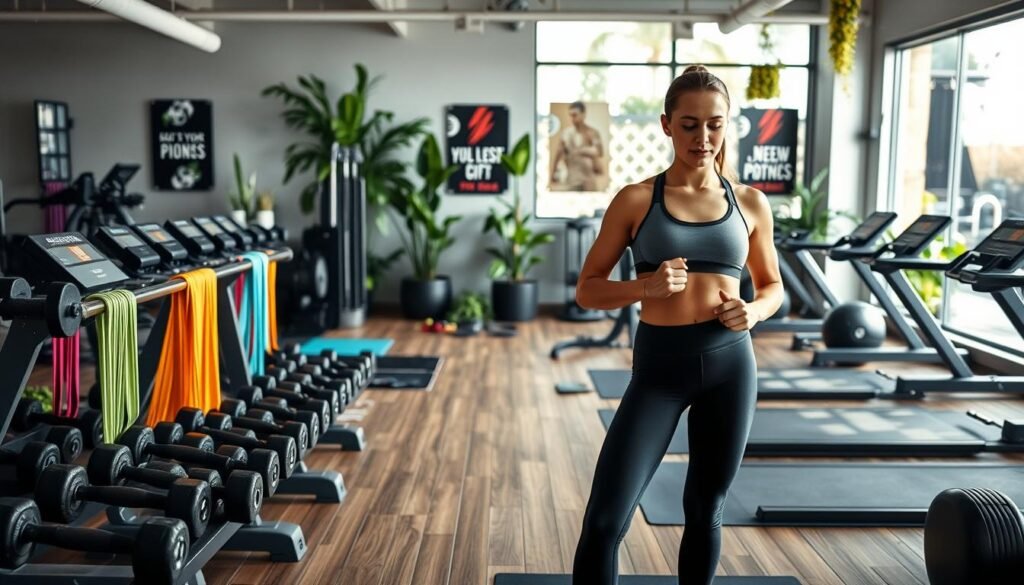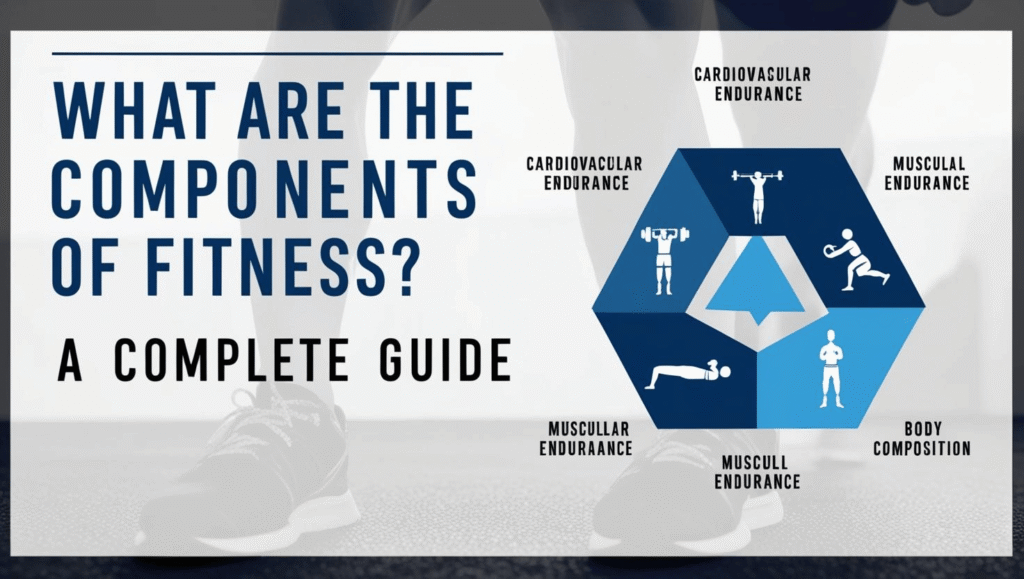Are you ready to transform your fitness journey and achieve your wellness goals? In this comprehensive guide, we’ll explore the essential steps to crafting a personalized workout plan that sets you up for long-term success. Whether you’re starting from scratch or looking to revamp your existing routine, our expert insights will empower you to approach your fitness journey with confidence and clarity.
Key Takeaways
- Understand the importance of planning your workout sessions for effective and sustainable results.
- Learn how to measure your current fitness level and establish meaningful benchmarks for progress tracking.
- Discover strategies to design a balanced fitness program tailored to your specific goals and needs.
- Explore essential equipment and gear to enhance your workout experience.
- Uncover techniques to start gradually, incorporate variety, and consistently monitor your progress.
As the summer season comes to a close, many individuals are eager to kickstart or reboot their exercise routines. In fact, But beyond the initial enthusiasm, the key to lasting fitness success lies in strategic planning and a holistic approach to your workouts. while This article will equip you with the tools and insights to transform your fitness aspirations into a sustainable reality.
Measure Your Fitness Level
Before embarking on a new fitness journey, it’s crucial to assess your current fitness level. This evaluation will provide valuable insights into your cardiovascular endurance, muscular strength, flexibility, and body composition – all of which are key indicators of overall health and wellness.
Evaluate Key Fitness Metrics
Start by measuring your heart rate, as a healthy adult’s resting heart rate should typically fall between 60 to 100 beats per minute. Your target heart rate zone, which is the optimal range for effective cardiovascular exercise, should be between 50% to 85% of your maximum heart rate for your age.
Next, consider your performance on fitness tests like the 1.5-mile run. Good fitness levels for this test range from 11 to 17.5 minutes for men and 13 to 16 minutes for women, depending on age. Similarly, the number of pushups you can complete is a reliable indicator of muscular strength, with good levels ranging from 10 to 28 for men and 10 to 20 for women, based on age.
Measuring your waist circumference is also essential, as a waist size of 35 inches or more for women and 40 inches or more for men indicates a higher risk of heart disease and type 2 diabetes. Additionally, calculating your body mass index (BMI) can provide insights into your weight status, with classifications ranging from underweight to obese.
Establish Benchmarks for Progress Tracking
After evaluating your current fitness metrics, it’s time to set clear benchmarks that will allow you to track your progress over time. This will help you measure the effectiveness of your workout plan and make necessary adjustments to achieve your fitness goals.
Remember, the key to success is consistently monitoring your fitness level and being willing to adapt your routine as needed. By establishing a solid baseline and setting achievable benchmarks, you’ll be well on your way to a healthier, more active lifestyle.
Design Your Fitness Program
Crafting an effective fitness program starts with setting clear, measurable goals. Whether your aim is to lose weight, build muscle, or enhance overall fitness, your objectives should be specific, achievable, and aligned with your lifestyle and preferences. Creating a balanced routine that incorporates various exercise types, such as cardio, strength training, and flexibility work, will help you achieve well-rounded fitness.
Set Clear Fitness Goals
Begin by defining your fitness goals. Do you want to shed a few pounds, increase your strength, or improve your cardiovascular endurance? Whatever your target, make sure it is specific, quantifiable, and realistic. For weight loss, a healthy rate is 0.5-1% of your body weight per week, with a recommended calorie deficit of 500 calories per day for a 200-pound individual. On the other hand, for muscle gain, a reasonable rate is 0.25-0.5% of your body weight per week, with a surplus of 250 calories per day for a 200-pound individual.
Create a Balanced Routine
To achieve your fitness goals, you’ll need a well-rounded workout plan. Incorporate a mix of cardio, strength training, and flexibility exercises to target all aspects of physical fitness. Compound exercises that engage multiple muscle groups, such as squats, deadlifts, and push-ups, are highly efficient and can lead to improvements in aerobic endurance, muscular fitness, and flexibility. Complement these compound exercises with targeted isolation exercises to address specific muscle groups and improve muscle awareness.
Designing a fitness program can be a rewarding process, but it’s essential to follow a structured approach. Set clear goals, create a balanced routine, and be consistent in your efforts. With dedication and the right plan, you’ll be well on your way to achieving your fitness aspirations.
https://www.youtube.com/watch?v=QelZiLJ6R1A
Gather Essential Equipment
Investing in the right workout equipment and fitness gear can elevate your home gym setup and make your workout sessions more efficient and enjoyable. To ensure your workouts are effective, it’s crucial to identify the essential items you’ll need, such as proper footwear, resistance bands, and any necessary home gym equipment, and ensure they meet your specific needs and fitness level.
When building your home gym, consider the following essential pieces of workout equipment:
- High-quality exercise mat for floor workouts and added comfort
- Adjustable resistance bands to target various muscle groups
- A sturdy exercise bench for strength training exercises
- Lightweight dumbbells or kettlebells for resistance training
- A stability ball for core strengthening and balance exercises
- A jump rope for efficient cardio workouts

Remember, the fitness gear you choose should not only meet your workout needs but also be comfortable and durable to support your fitness journey. By investing in the right workout equipment, you’ll be well on your way to creating an effective and personalized home gym setup that will help you achieve your fitness goals.
“The right equipment can make all the difference in maintaining a consistent and effective workout routine.”
Get Started with Your Workout Plan
When beginning a new workout routine, it’s crucial to start slowly and gradually increase the intensity and duration of your sessions.1 kjb>This will help prevent injury and ensure a sustainable long-term approach. To keep your workouts engaging and prevent boredom, incorporate a variety of exercises and activities, and don’t be afraid to get creative with your fitness routine.
Start Slowly and Build Up Gradually
It’s important to listen to your body’s signals, rest when needed, and avoid pushing through pain.The minimum recommended exercise duration is at least 150 minutes per week, but it’s crucial to start gradually and allow your body to rest. Warming up before exercise helps prevent injuries and improve performance, while cooling down afterward helps your body return to its normal state and reduce muscle soreness.
Incorporate Variety and Creativity
Common types of exercises include aerobic, strength, calisthenics, high-intensity interval training (HIIT), boot camps, balance or stability exercises, and flexibility exercises. Mixing up your workouts, joining a gym, participating in team sports, hiring a personal trainer, working out with a friend, and tracking your progress can help maintain your motivation for exercise.

Hydration is crucial during and after exercise to maintain optimal performance and aid in recovery. Consuming a balanced diet with essential macronutrients like carbs, protein, and healthy fats is key for supporting your workouts.
“It is essential to listen to the body’s signals, rest when needed, avoid pushing through pain, progress gradually through the fitness program, and focus on enjoyment to maintain motivation for exercising regularly.”
By starting slowly, incorporating variety, and embracing creativity, you can successfully begin your new workout plan and enjoy the many benefits of regular exercise.
Check and Track Your Progress
Regularly monitoring and reassessing your fitness progress is crucial for staying motivated and achieving your goals. Periodically evaluating your key fitness metrics can help you make any necessary adjustments to your goals or workout routine, ensuring continued progress and preventing plateaus.
Reassess Fitness Periodically
Take the time to track fitness progress by recording important details like the exercises you perform, the number of reps and sets, the weights used, and the duration of your workouts. This can be done quickly and easily using a workout journal or a fitness tracking app like MyFitnessPal or FitNotes. Regularly documenting how you feel after each session can also provide valuable insights into your overall fitness level and any areas that may need further attention.
Adjust Goals and Activities as Needed
As you reassess fitness and monitor your progress, be prepared to adjust goals and activities as needed. If you notice that certain goals are becoming too easy or too challenging, don’t hesitate to refine them to maintain the right level of difficulty and keep you motivated. Similarly, if your current workout routine is no longer providing the desired results, consider mixing things up by incorporating new exercises or adjusting the intensity and duration of your sessions.
![]()
“The key to long-term fitness success is consistently reassessing your goals and adapting your routine to ensure continued growth and development.”
Remember, the journey to a healthier and fitter you is an ongoing process, and by regularly tracking fitness progress, reassessing fitness, and adjusting goals and activities as needed, you’ll be well on your way to achieving your personal fitness objectives.
Planning Workout Sessions
Effective workout planning is the key to unlocking your fitness potential. By incorporating exercise into your daily life and prioritizing your well-being, you can achieve consistent progress and reap the full benefits of your fitness routine.
To start, consider your personal schedule and find creative ways to fit in physical activity. Personal trainers in England typically charge between £30 to £65 per hour, with rates in larger cities like London reaching £80 to £100 per hour due to the higher cost of living and greater demand. Session duration for personal training typically ranges between 45 to 60 minutes, striking a balance between an effective workout and fitting into clients’ schedules.
When setting fitness goals, it’s crucial to use the SMART (Specific, Measurable, Achievable, Relevant, Time-bound) framework to ensure they are realistic and attainable. Warm-up exercises like jumping jacks, arm circles, and bodyweight squats can help prepare both your mind and body for the workout ahead.
Complementing your fitness routine with a balanced diet is also essential. Providing nutrition plans and suggesting healthier alternatives such as nuts, Greek yogurt, water, herbal teas, fruits, vegetables, and whole grains can support your goals. Regular communication and progress updates will help maintain your accountability, commitment, and motivation.
Tailoring your workout sessions to your specific needs and goals is key. Offering a mix of push days, pull days, leg days, and incorporating cool-down exercises ensures a comprehensive fitness experience. Considering package deals or discounts for clients booking multiple sessions upfront can be an effective pricing strategy for personal trainers.
By planning your workout sessions strategically, you can maximize the efficiency of your fitness routine and achieve your goals more effectively. Remember to stay consistent, be adaptable, and prioritize your health and well-being for a truly transformative fitness journey.
Choosing the Right Exercises
When designing your workout plan, it’s important to focus on compound exercises that engage multiple muscle groups simultaneously. These exercises not only save time but also provide a more efficient and effective way to build strength and improve overall fitness. Targeting the major muscle groups in your routine will help you achieve a well-rounded, balanced physique.
Prioritize Compound Exercises
Compound exercises, such as back squats, deadlifts, and push presses, are recommended for improving full-body strength. Research suggests that these exercises should be prioritized at the beginning of a workout session for optimal benefits. Studies have shown that performing compound exercises at the start of a workout leads to greater improvements compared to doing them towards the end of the routine, applicable to both male and female exercisers.
Target Major Muscle Groups
To enhance muscle strength, it is recommended to include exercises for all major muscle groups at least two times per week, allowing for 48 hours of rest between sessions. Adequate recovery time of at least 48 hours between strength training sessions is crucial for muscle repair and growth. Proper form and controlled movements during strength training exercises help prevent injuries and maximize the effectiveness of the workout. Gradually increasing the challenge by adjusting weights or resistance bands is key to continuously strengthening muscles.

“Compound exercises are the cornerstone of an effective strength training program, helping you build muscle and improve overall fitness efficiently.”
| Exercise | Target Muscle Groups |
|---|---|
| Back Squat | Quadriceps, Glutes, Hamstrings |
| Deadlift | Back, Hamstrings, Glutes |
| Push Press | Shoulders, Triceps, Core |
| Pull-up | Back, Biceps, Grip Strength |
Balancing Different Exercise Types
To achieve the best results, it’s crucial to incorporate a balanced workout routine that includes a variety of exercise types. By incorporating exercise variety, you can address all aspects of fitness and maximize the benefits of your workout plan.
Cardiovascular activities, such as running, cycling, or swimming, provide excellent heart health and endurance benefits.
Strength training, on the other hand, helps build muscle, increase bone density, and boost metabolism. Incorporating a mix of compound exercises and targeted muscle group workouts can provide a well-rounded strength training routine.
Flexibility exercises, such as stretching and yoga, improve range of motion, reduce the risk of injury, and promote overall body balance.
By balancing different exercise types in your routine, you’ll be able to address all aspects of fitness, from cardiovascular health and muscular strength to flexibility and balance. This comprehensive approach will help you achieve your fitness goals and maintain a healthy, active lifestyle.
- Incorporate cardiovascular, strength, and flexibility exercises into your routine
- Allow for proper recovery time between strength training sessions
- Experiment with different exercise modalities to find the right balance
- Consider working with a fitness professional to create a personalized, balanced workout routine
| Exercise Type | Benefits | Recommendations |
|---|---|---|
| Cardiovascular | Improved heart health and endurance | 150 minutes of moderate activity per week, running/biking for longevity |
| Strength Training | Increased muscle, bone density, and metabolism | Allow 48 hours of recovery between sessions for the same muscle group |
| Flexibility | Improved range of motion, reduced injury risk, and body balance | Incorporate stretching and yoga, HIIT workouts provide similar benefits |
“By balancing different exercise types in your routine, you’ll be able to address all aspects of fitness, from cardiovascular health and muscular strength to flexibility and balance.”
Conclusion
In conclusion, planning an effective workout routine is the foundation for achieving your fitness goals. By assessing your current fitness level, designing a personalized program, gathering the right equipment, and consistently tracking your progress, you can create a sustainable and successful workout plan that helps you get fit and healthy.
Key principles such as specificity, progressive overload, recovery, reversibility, and individuality are essential in designing gym-based exercise programs that cater to each client’s unique needs and goals. Factors like screening, lifestyle habits, medical history, and client preferences should be carefully considered to ensure the program’s effectiveness and adherence.
Personalized and client-centric goals can help channel focus and resources effectively, leading to better outcomes. By categorizing goals into areas like general health, physiological aspects, psychological well-being, and functional capabilities, you can create a comprehensive plan that addresses the client’s holistic needs. Additionally, using personal trainer software can streamline operations, provide customizable templates, and enable real-time monitoring of client progress to dynamically adjust the plan as needed.
FAQ
How can I assess my current fitness level before starting a new workout routine?
What should I consider when designing an effective fitness program?
What type of equipment do I need to start a new workout routine?
How should I approach starting a new workout routine?
How can I effectively track my fitness progress?
What are some strategies for incorporating exercise into my daily life?
What types of exercises should I focus on in my workout routine?
How should I balance different types of exercise in my routine?
Source Links
- Measure your fitness level with these simple tests
- Program Design 101: How to Build Your Own Workout Program | TrainHeroic
- How To Build Your Own Workout Routine (Plans & Exercises)
- 5 basics of a well-rounded fitness routine
- The 12 Secrets to Building (and Sticking to) Your Workout Routine
- How to Start Exercising: A Beginner’s Guide to Working Out
- Hacking the Workout Journal: How to Track Your Workouts in the Simplest, Most Effective Way Possible
- 6 Ways To Track Your Fitness Progress
- How to plan a personal training session | UNTIL
- How to Build an Exercise Plan – HelpGuide.org
- Does It Matter How You Order Your Exercises at the Gym?
- Balance exercises: 13 Moves with Instructions
- The Weekly Workout Planner: How to Create Efficient Plans for Your Clients
- LO1 of Unit 5 – How to plan and tailor safe and effective gym-based exercise programmes for a range of clients – PT Institute




